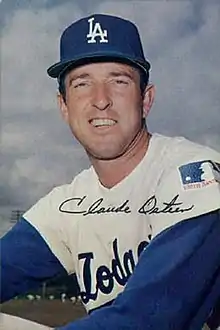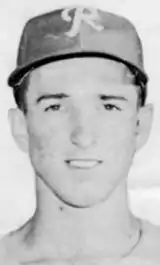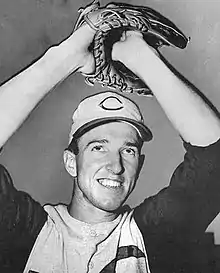Claude Osteen
Claude Wilson Osteen (born August 9, 1939), nicknamed "Gomer" because of his resemblance to television character Gomer Pyle,[1] is an American former professional baseball left-handed pitcher, who played in Major League Baseball (MLB) for the Cincinnati Redlegs/Reds, Washington Senators, Los Angeles Dodgers, Houston Astros, St. Louis Cardinals, and Chicago White Sox.[2]
| Claude Osteen | |||
|---|---|---|---|
 | |||
| Pitcher | |||
| Born: August 9, 1939 Caney Spring, Tennessee | |||
| |||
| MLB debut | |||
| July 6, 1957, for the Cincinnati Redlegs | |||
| Last MLB appearance | |||
| September 27, 1975, for the Chicago White Sox | |||
| MLB statistics | |||
| Win–loss record | 196–195 | ||
| Earned run average | 3.30 | ||
| Strikeouts | 1,612 | ||
| Teams | |||
| Career highlights and awards | |||
Career overview
The most significant portion of Osteen's career was spent with the Dodgers. A "Bonus Baby" who never really received a season-long chance to start in Cincinnati, he was traded on Sept. 16, 1961, from Cincinnati to the Washington Senators for pitcher Dave Sisler.[2] With the Senators, Osteen finally got a chance to start regularly in the big leagues, albeit with a consistently sub-.500 team. After posting a winning record (15–13) in 1964,[2] he was in much demand that winter. On December 4, 1964, Osteen was traded by the Senators to the Dodgers in a 7-player deal, with five players (two of whom were Frank Howard and Pete Richert) going to the Senators.[2][3] Osteen developed into one of the game's better starters in Los Angeles.
After two years with an earned run average (ERA) under 3.00 (1965–1966),[2] Osteen was considered a top-notch starter and a workhorse. In those two years, Osteen and the Dodgers reached two straight World Series (the only two he would reach in his career). In the 1965 World Series, the Dodgers went on to beat the Minnesota Twins in 7 games, with Osteen pitching brilliantly. He had a 0.64 ERA in the Series, with a 1–1 record including a shutout,[4] which came after teammates Don Drysdale and Sandy Koufax had lost their respective games (the first two games of the Series). In the 1966 World Series, the Dodgers were beaten by the Baltimore Orioles in four games. Osteen was charged with the loss, in a 1–0 pitcher's duel with Wally Bunker in Game 3, despite giving up only three hits in seven innings; a home run by Paul Blair accounted for the game's only run. Osteen's final postseason statistics include a 0.86 ERA with seven strikeouts in 21 innings pitched.

In 1967, Osteen reached his first All-Star game. His season totals included going 17–17, with a 3.22 ERA, in 2881⁄3 innings pitched. He hurled 14 complete games, with five shutouts. In 1968, Osteen was one of the game's consistent hard-luck losers; despite a very respectable 3.08 ERA, he only won 12 of 30 decisions. The 12 victories would be his fewest in a season from 1964 to 1973; the 18 losses tied him with Ray Sadecki for the major league lead. In 1969, Osteen won 20 games for the first time[2] and set a number of career highs, including 321 innings pitched, 183 strikeouts, 16 complete games, and 7 shutouts.
In the 1970s, Osteen was still pitching an average of 260 innings a year. In the 1970 All-Star game, Osteen pitched three shutout innings, notching the win, in a game most remembered for the play in which Pete Rose barreled into Ray Fosse to score the winning run in the 12th inning. Coincidentally, like Osteen, the pitcher and hitter involved in the walk-off single were also Tennessee natives: Jim Hickman (who had been a Dodger teammate of Osteen's in 1967) collected the hit off losing pitcher Clyde Wright (coincidentally, Hickman and Wright would become Comeback Players of the Year in their respective leagues).
In 1972, Osteen had a particularly strong year, finishing with 7 complete game victories in his last 9 starts. That year, he was 20–11, with a 2.64 ERA, in 252 innings pitched.[2]

Osteen made his 3rd and final All-Star team in 1973, in what would prove to be his last real quality MLB campaign — and his last season with the Dodgers. That year, while pitching for a 2nd-place Dodger team, Osteen went 16–11 and posted a 3.31 ERA, while logging 33 starts, 12 complete games, and 3 shutouts. He had achieved double-figure wins each year, for 10 consecutive seasons (1964–1973).
Prior to the 1974 season, the Dodgers traded Osteen to the Houston Astros for outfielder Jimmy Wynn.[2][3] Wynn helped the Dodgers win the 1974 NL pennant The Astros traded Osteen to the St. Louis Cardinals in August 1974. On September 11, 1974 he pitched 91⁄3 innings of relief against the New York Mets in a 25 inning game, won by St. Louis 4–3. He did not figure in the decision. In April 1975, he was released by the Cardinals and was signed by the Chicago White Sox, for whom he played his final game on September 27, 1975. That following spring, when Osteen no longer fit in the ChiSox’ future plans, the team released him.[2]
Over the course of an 18-year professional career, Osteen compiled 196 wins, 1,612 strikeouts, and a 3.30 ERA.[2]
As a batter, Osteen had a lifetime .188 batting average, with 8 home runs, and 76 runs batted in (RBI).[2] He was used as pinch hitter on a number of occasions. Defensively, he recorded a .971 fielding percentage which was 18 points higher than the league average at his position.[2]
Beginning in 1977, Osteen became a big league pitching coach for the Cardinals, Philadelphia Phillies, Texas Rangers, and Dodgers.[5] He also coached various minor league teams.
Highlights
- 3-time All-Star (1967, 1970, 1973)
- Top 10 in the league in games started, 10 times (1964, 1965, 1966, 1967, 1968, 1969, 1970, 1971, 1972, 1975)
- 2nd in the league in shutouts 3 times (1967, 1969, 1970); top 10 in the league 3 more times (1971, 1972, 1973)
- Top 10 in the league in innings pitched, 6 times (1964, 1965, 1967, 1969, 1970, 1972)
- Top 10 in ERA, 3 times (1965, 1966, 1972)
- Ranks #77 in all-time innings pitched (34602⁄3)[6]
- Ranks #44 (tie) in all-time shutouts (40)[7]
- Ranks #54 in all-time games started (488)[8]
See also
References
- Wolf, Gregory H (September 15, 2011). "Claude Osteen | SABR Baseball BioProject". SABR.org. Society for American Baseball Research. Retrieved August 27, 2019.
- "Claude Osteen Stats". Baseball-Reference.com. Sports Reference LLC. 2019. Retrieved August 27, 2019.
- Elliott, Helene (July 7, 2011). "Local trades: A look at the smash hits and flops". latimes.com. Los Angeles Times. Retrieved August 27, 2019.
- King, Norm (2019). "October 9, 1965: Well, golly: 'Gomer' Claude Osteen gets Dodgers back in the Series". SABR.org. Society for American Baseball Research. Retrieved August 27, 2019.
- "Claude Osteen Coaching Record". retrosheet.org. Retrosheet. 2019. Retrieved August 27, 2019.
- "Career Leaders & Records for Innings Pitched". Baseball-Reference.com. Sports Reference LLC. 2019. Retrieved August 27, 2019.
- "Career Leaders & Records for Shutouts". Baseball-Reference.com. Sports Reference LLC. 2019. Retrieved August 27, 2019.
- "Career Leaders & Records for Games Started". Baseball-Reference.com. Sports Reference LLC. 2019. Retrieved August 27, 2019.
External links
- Career statistics and player information from MLB, or Baseball-Reference, or Fangraphs, or Baseball-Reference (Minors), or Retrosheet
- Claude Osteen at SABR (Baseball BioProject)
- Claude Osteen at Tennessee Encyclopedia
| Awards and achievements | ||
|---|---|---|
| Preceded by Don Rudolph |
Washington Senators Opening Day Starting pitcher 1964 |
Succeeded by Phil Ortega |
| Preceded by Don Drysdale Bob Miller Don Drysdale |
Los Angeles Dodgers Opening Day Starting pitcher 1966 1968 1970 |
Succeeded by Bob Miller Don Drysdale Bill Singer |
| Sporting positions | ||
| Preceded by Bob Milliken |
St. Louis Cardinals Pitching Coach 1977–1980 |
Succeeded by Hub Kittle |
| Preceded by Herm Starrette |
Philadelphia Phillies Pitching Coach 1982–1988 |
Succeeded by Darold Knowles |
| Preceded by Tom House |
Texas Rangers Pitching Coach 1993–1994 |
Succeeded by Dick Bosman |
| Preceded by Charlie Hough |
Los Angeles Dodgers Pitching Coach 1999–2000 |
Succeeded by Dave Wallace |